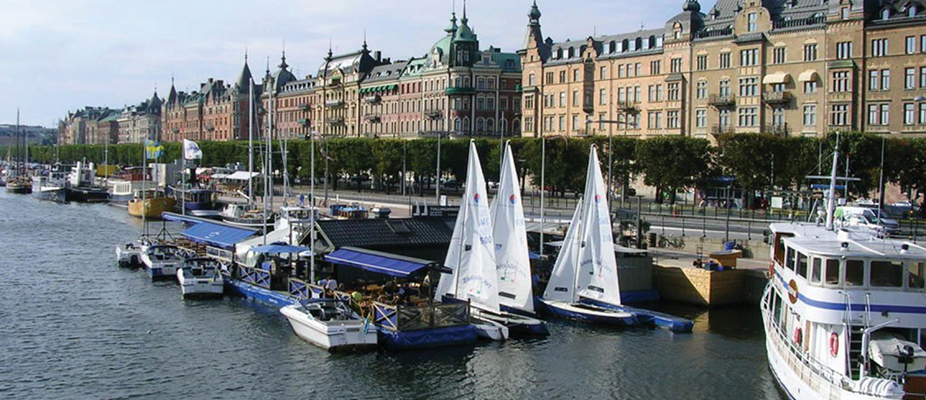2 Europe
2.1 Introducing the Realm
Learning Objectives
- Describe the various climate types and physical landforms of the European continent.
- Explain how Europe’s physical geography has supported its development.
- List Europe’s various natural resources.
- Summarize the environmental concerns Europe faces.
Europe is a continent of peninsulas, islands, and varied landforms. The traditional boundaries of the European continent include the North Atlantic Ocean to the west and Russia as far as the Ural Mountains to the east. Since the Soviet Union’s collapse in 1991, Russia has been given its own identification and, in this text, is not included in the study of Europe. Russia will be discussed in Chapter 3. Greenland is located next to the North American country of Canada but has traditionally been considered a part of Europe because of Denmark’s colonial acquisition of the island. The Arctic Ocean creates a natural boundary to the north. The southern boundary of Europe is the Mediterranean Sea and includes the islands of Malta and Cyprus as independent countries. A portion of Turkey is in Europe, but Turkey is considered a part of Asia Minor and is usually included in the study of the Middle East region. The waterway in Turkey between the Black Sea and the Aegean Sea is the Bosporus, or the Istanbul Strait, which creates a natural border between Asia and Europe. Europe is also close to North Africa, and Morocco’s coast can be seen across the Strait of Gibraltar from Spain.
From the Roman Empire to the European Union (EU), Europe’s historical pattern of development is a model study in regional geography. From historic empires to diverse nation-states to a multi-country union, the continent struggles to confront the cultural forces that unite and divide it. The powerful impact European colonialism has had on the world since the Industrial Revolution is still felt today. The rural-to-urban shift prompted by the Industrial Revolution first impacted Europe and continues to impact developing countries. Understanding the geographic region of Europe is essential to understanding our world. This short summary of the basic concepts will provide a valuable lesson in globalization, which affects every human being on the planet. The concepts and principles that apply to Europe can also apply to other countries and regions.

A. Location and Climate
Europe is a northern continent. All the British Isles, for example, fall above the fiftieth parallel. Much of Europe lies north of the United States. Paris, France, is at about the same latitude as Fargo, North Dakota. Athens, Greece, is at about the same latitude as St. Louis, Missouri. Europe’s northern position affects its growing seasons and people’s moods, and should be taken into consideration as an important influence in the evolution of the European character. Europe is also surrounded by water: the Atlantic Ocean borders Europe on the west, the Arctic Ocean borders it to the north, and many seas surround the peninsulas and coastal regions.
The oceans exert significant influence on the world’s climates. The oceans collect and store vast amounts of solar energy, particularly around the equator, and transport that heat with their currents. Ocean currents can move water for thousands of miles from one temperature zone to another. Because oceans can absorb so much heat, maritime climates are milder than continental ones, with smaller temperature variations from day to night as well as from winter to summer. Since water heats and cools more slowly than land, coastal communities have climates that tend to be more moderate than one might imagine for places so far north. Interior Europe does not benefit from coastal waters and is thus more continental and can have winters as cold as those found within the upper Midwestern United States.
The Gulf Stream is perhaps the most important current for Western Europe’s climate and is responsible for producing a temperate climate for a northern latitude location. Most of Western Europe has a moderate type C climate. The Gulf Stream originates in the Gulf of Mexico, where the waters are warmed. This powerful current follows the Eastern Seaboard of the United States before crossing the Atlantic Ocean for Europe, where it is called the North Atlantic Drift or North Atlantic Current. The North Atlantic Current’s most dramatic effect can be found in the western coastal islands of Scotland, which have a mild enough climate to support some forms of tropical flora, even though they are about as far north as Hudson Bay, Canada. The coast of Norway provides another example. While most of Norway’s coastal area lies within the Arctic region, it remains free of ice and snow throughout the winter.
People living farther inland and closer to Eastern Europe and Russia encounter the colder type D climates. Colder air sweeps down from the Arctic north or from eastern Siberia and provides colder winters in this eastern region. The Mediterranean Sea moderates the temperature to the south, providing a type C climate around its shores. Type C climates meet up with type E climates at or near the Arctic Circle in Norway and in Iceland.
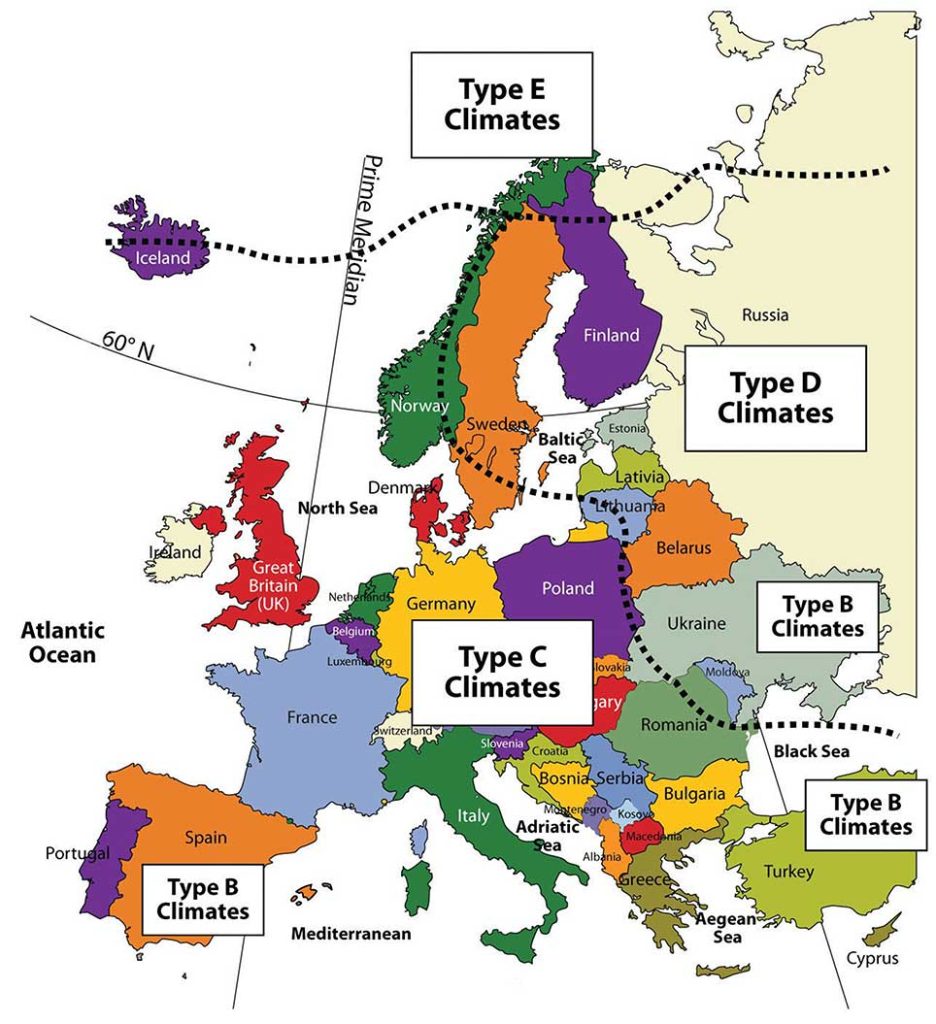
B. Four Main European Landforms
Europe has four main landforms, many islands and peninsulas, and various climate types. The four main landforms include the Alpine region, Central Uplands, Northern Lowlands, and Western Highlands. Each represents a different physical part of Europe. The wide-ranging physical environment has provided Europe with an abundance of biodiversity. Biodiversity refers to the diversity of the number of species in an ecosystem and the quantity of members in each species. The physical environment also provides natural resources and raw materials for human activities. Europe’s moderate climates and favorable relative location are supported by its access to the many rivers and seas.
These advantageous developmental factors supported the development of the Industrial Revolution in Europe, which gave rise to highly technical and urban societies. Europe has emerged as one of the core economic centers of the global economy. Associated with the urbanization of Europe are high human population densities that have placed a strain on the natural environment. As result, there has been significant deforestation and the loss of natural habitat, which has in turn has decreased the realm’s level of biodiversity.
Rivers are abundant in Europe and have provided adequate transportation for travel and trade throughout its history. Most of Europe is accessible by water transport either via the many rivers or along the extensive coastlines of the peninsulas and islands. Two main rivers divide Europe: the Danube and the Rhine. Both have their origins in the region of southern Germany on or near the border with Switzerland. The Rhine River flows north and empties into the North Sea in Rotterdam, The Netherlands, one of the world’s busiest ports. The Danube flows east through various major European cities, such as Vienna, Budapest, and Belgrade before emptying into the Black Sea.
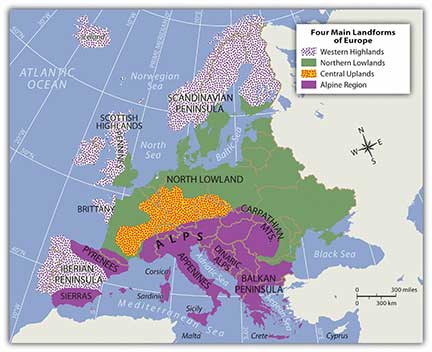
C. Alpine Region
The High Alps, which range from eastern France to Slovenia, are central to the Alpine region. Included in the Alpine Range are the Pyrenees, located on the border between France and Spain; the Apennines, running the length of Italy; the Carpathians, looping around Romania from Slovakia; and finally, the shorter Dinaric Alps in former Yugoslavia. Mountains usually provide minerals and ores that were placed there when the earth’s internal processes created the mountains. Mountains also isolate people by acting as a dividing range that can separate people into cultural groups.
The Alpine region encircles the Mediterranean coastlines, which have more temperate type C climates that are particularly warm with hot, dry summers and cool, wet winters. This climate type allows for the cultivation of food products such as olives, citrus fruit, figs, apricots, and grapes. Evergreen scrub oaks and other drought-resistant shrubs are common in the Mediterranean region.
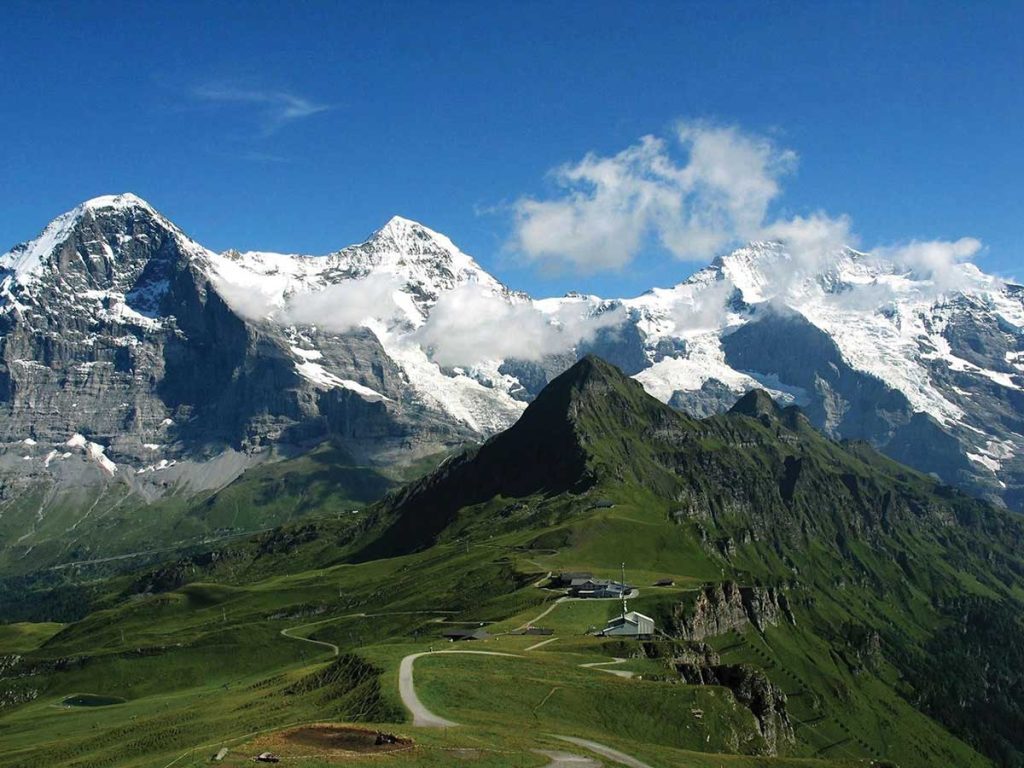
D. The Central Uplands
The region bordering the main Alps to the north, which includes a large portion of southern Germany extending eastward, is known as the Central Uplands. These foothills to the Alps are excellent sources of raw materials such as forest products and coal, which are valuable resources for industrial activities. The Central Uplands are also good locations for dairy farming and cattle raising. This middle portion of the continent has a mixed deciduous-coniferous forest, and the vegetation includes oak, elm, and maple trees intermingled with pine and fir trees. There are four distinct seasons in this region with moderate amounts of precipitation year round.
E. Northern Lowlands
Similar to the breadbasket of the Midwestern United States, Europe’s Northern Lowlands possess excellent farmland. Major agricultural operations here provide for a large European population. The land is flat to rolling with relatively good soils. The Northern Lowlands are a great plain that extends across northern Europe from southern France, north through Germany, and then all the way east to the Ural Mountains of Russia. This area is typified by prairies and areas of tall grasses and is mostly used as farmland. The lowlands area also contains bogs, heaths, and lakes. The eastern part of this great plain around Ukraine is characterized by a steppe biome. It is a flat and relatively dry region with short grasses and is generally an agricultural region. This eastern area has great swings in temperature, both from day to night and from summer to winter. Winter temperatures in the eastern steppe can drop to below −40 °F, with summer temperatures reaching as high as 105 °F. This is similar to the steppes of eastern Montana or western North Dakota in the United States.
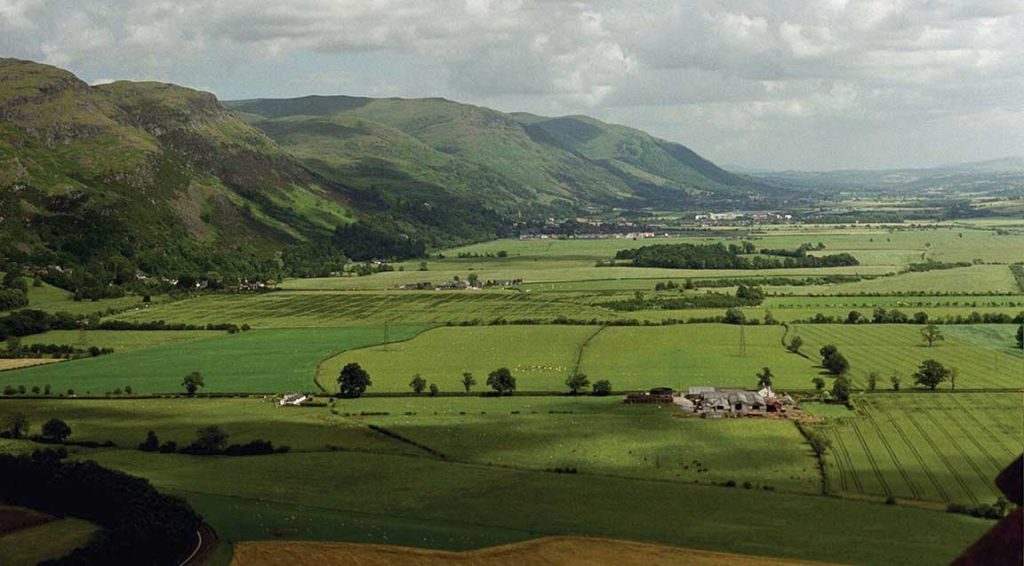
F. Western Highlands
On the western edges of the European continent arise short rugged mountains called highlands that extend throughout Norway, parts of Britain, and portions of the Iberian Peninsula of Portugal and Spain. These Western Highlands hold sparser populations and are less attractive to large farming operations. Agriculture is usually limited to grazing livestock or farming in the valleys and meadows. The Scottish Highlands are noted for their wool products and Highland cattle. In England, the central chain of highlands called the Pennines proved valuable during the Industrial Revolution because they enabled hydropower and, later, coal mining. Coal mining was prominent in the highland regions of Wales. In the far northern regions of Scandinavia, tundra environments prevail. In this coldest and driest biome, permafrost dominates the landscape, and the land becomes soggy for brief periods during the few weeks of summer. The flora consists primarily of lichens, mosses, low shrubs, and wildflowers.
G. Natural Resources in Europe
The physical landforms of Europe provide diverse geographic opportunities that have catapulted Europe through the Industrial Revolution and into the information age. With an abundance of natural resources, European countries have gained wealth from the land and leveraged their geographic location to develop a powerhouse of economic activity for the global marketplace. Europe has placed a strong focus on manufacturing activity to take advantage of its natural resources. The highly urbanized society has struggled to find a balance between modernization and environmental concerns. Industrial activities have contributed to the degradation of the environment and the demise of a number of species.
Different regions of Europe are blessed with fresh water supplies, good soils, and various minerals. Chief among the mineral deposits in Europe is iron ore, which can be found in Sweden, France, and Ukraine. Other minerals exist in smaller quantities, including copper, lead, bauxite, manganese, nickel, gold, silver, potash, clay, gypsum, dolomite, and salt. Extraction activities have supported the continent’s industrialization.
The ready access to vast areas of the Atlantic Ocean and a number of major seas, lakes, and rivers has elevated fish to an important natural resource in Europe. The seas around Europe provide about 10 percent of the world’s fish catches. Europeans are becoming increasingly aware of the effects of overfishing. Stocks of Atlantic cod and Atlantic mackerel are considered to be at risk because of the twin threats of overfishing and changes in the environment that are affecting natural mortality and slowing spawning.
Forest covers more than 40 percent of the continent’s land area, with the majority on the Russian side. Forests exist primarily in the less populous Nordic and Baltic countries and in Central Europe. About half the forest land in Europe is privately owned. The percentage of forested land in Europe is rebounding because of an extensive tree-planting initiative since 2000.
Coal, now substantially depleted, is abundant in several areas of Great Britain as well as in the industrial centers of Germany and in Ukraine. Other coal deposits are found in Belgium, France, Spain, the Czech Republic, Poland, Slovakia, and Russia. The burning of coal has produced high levels of air pollution. Acid rain has been a major concern in the northern countries, where wind currents carry pollutants north into Scandinavia from the industrial regions of Central Europe. In Scandinavia, acid rain has diminished fish populations in many of the lakes. Forest health is also being challenged, which is diminishing the economic conditions of regions that depend on forests for their economic survival.
Petroleum and natural gas deposits exist underneath the North Sea and were first tapped in the 1970s. Five European countries have rights to these resources, including Norway, the United Kingdom, Denmark, the Netherlands, and Germany, with Norway holding the bulk of the rights. The governments of these five nations agree that, although tapped only decades ago, half the North Sea oil reserves have been consumed.
Before the extraction of petroleum products from the North Sea, Russia and the former Soviet Union’s other republics supplied petroleum to Europe. These areas still have a number of active extraction operations. Hydroelectric power has been important in Europe as well. With both coal and oil resources largely depleted and the desire to avoid the environmental damage caused by dams, the European Energy Commission is devoting substantial energy and resources to encouraging use of renewable resources such as wind and solar energy. In March 2007, European leaders agreed that a binding target of 20 percent of all energy must be from alternative sources by 2020. Also, 10 percent of the transportation fuels used by EU members must be sustainable biofuels.
Key Takeaways
- The Gulf Stream provides a moderate type C climate for much of Western Europe. Eastern Europe can experience colder type D climates.
- Europe has four main physical landforms that provide a diversity of natural resources. The North European Lowland holds the majority of its agricultural potential.
- An increase in population has also increased the demand on the environment. Various environmental concerns are becoming more evident. Acid rain from industrialization has caused extensive damage to forests and fish populations in northern Europe. Atlantic fisheries are also experiencing a decline in production.
2.2 Historical Development Patterns
Learning Objectives
- Outline how the Roman Empire and the Viking era contributed to European development.
- Describe how European colonialism changed or influenced other countries.
- Explain the major developments that prompted the Industrial Revolution.
- Summarize the impact of the rural-to-urban shift and its impact on urbanization specifically.
- Outline the concept of a nation-state and explain how this applies to Europe.
- Explain how cultural forces can positively or negatively influence political units.
- Identify the three main language groups and the three main religious denominations of Europe.
Europe didn’t become a center for world economics with high standards of living by accident. Historical events in global development have favored this realm because of its physical geography and cultural factors. In southern Europe, the Greeks provided ideas, philosophy, and organization. Greek thinkers promoted the concept of democracy. The Romans carried the concept of empire to new levels. From about 150 BCE to 475 CE, the Romans brought many ideas together and controlled a large portion of Europe and North Africa. The Roman Empire introduced a common infrastructure to Europe. The Romans connected their world by building roads, bridges, aqueducts, and port facilities. They understood how to rule an empire. By taking advantage of the best opportunities of each region they controlled, they encouraged the best and most-skilled artisans to focus on what they did best. This created the specialization of goods and a market economy. No longer did everyone have to make everything for themselves. They could sell in the market what they produced and purchase products made by others, which would be of higher quality than what they could make at home. Regions that specialized in certain goods due to local resources or specialty skills could transport those goods to markets long distances away. The Roman Empire connected southern Europe and North Africa.
The Vikings of Scandinavia (Norway, Sweden, and Denmark; 900–1200 CE) are often inaccurately referred to as rogue bands of armed warriors who pillaged and plundered northern Europe. Though they were fierce warriors in battle, they were actually farmers, skilled craftsmen, and active traders. They developed trade routes throughout the north. Using their seafaring knowledge and skills, the Vikings used Europe’s waterways for transportation. They were the early developers of the northern world from Russia to Iceland and even to North America. They developed colonies in Iceland, Greenland, and what is present-day Canada. Their longships were renowned for versatility and provided an advantage on the sea. The Vikings made advances deep into Europe—all the way to Constantinople. History indicates that the Byzantine Empire employed Scandinavian Vikings as mercenaries.
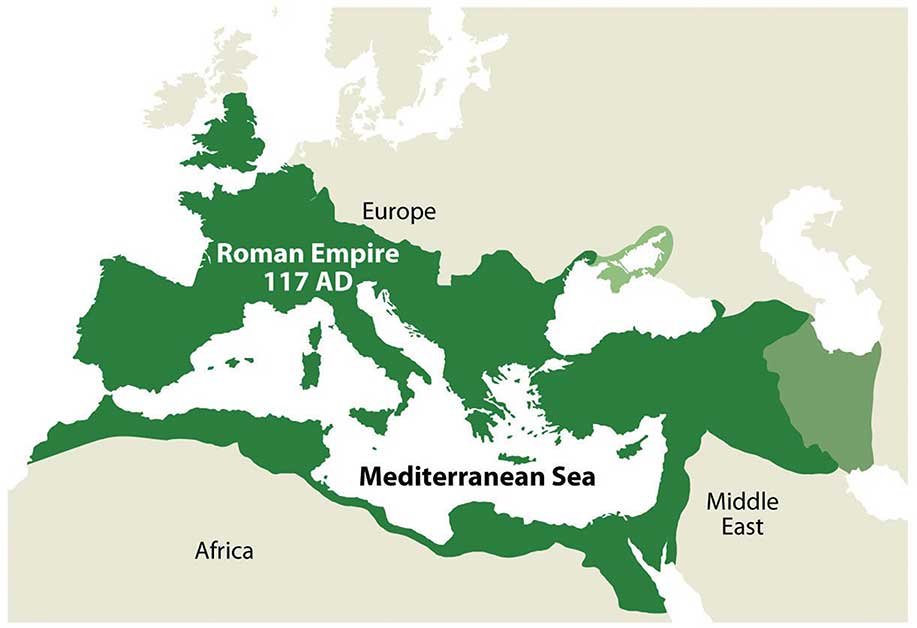
A. Colonialism
It wasn’t until after the Dark Ages of Europe ended that a rebirth of ideas, technology, and progress took hold. The Renaissance of the late fifteenth century prompted activity in Europe that changed the world. In 1492, Columbus and his three ships crossed the Atlantic to land on the shores of the Americas, in what are now known as the Bahamas. This event symbolized the beginning of the era of European colonialism, which only diminished after World War II. Colonialism’s effects remain in the colonies or protectorates that European countries still possess. Colonialism was fueled by the economic concept of mercantilism that included the drive of governments to control trade, promoting the acquisition of wealth by the quick gain of gold or silver from their colonies.
Colonialism included the development of colonies outside the home country, usually for the expansion of imperial power and the exploitation of material gain. The building of larger ships and an understanding of sea travel allowed an exchange of new goods and ideas between continents. North and South America were opened up to the European explorers for colonial expansion. European colonialism brought newfound wealth from the colonies back to Europe. All the regions of the world outside Europe were targeted for colonialism. Africa was divided up, “Latin” America was created, and Asia became a target for resources and trade. The few powerful countries along the Atlantic coast of Europe began the drive to dominate their world. If you live in the Western Hemisphere, consider the language you speak and the borders of your country: both were most likely products of European colonialism. Most of the current political geographic boundaries were drawn up or shaped through colonial conflict or agreement. For better or worse, understanding much of the world’s current cultural and political geography requires an understanding of European colonialism.
B. The Agrarian Revolution
The post-Renaissance era introduced a number of agricultural changes that impacted European food production. Before this time, most agricultural methods were primitive and labor intensive, but new technologies were introduced that greatly enhanced agricultural production. Plows, seeders, and harvesting technologies were introduced, and land reform and land ownership transitioned to adapt to the changing times. These innovations supported the expanding port cities that created urban markets for agricultural surpluses. Colonial ships returned from the colonies with new crops such as the potato that revolutionized crop production.
This era’s progress in agricultural advancements is often referred to as the agrarian revolution. The agrarian revolution led to the industrial developments such as the steam tractor and steel implements that further advanced agricultural production worldwide.
C. The Industrial Revolution
Great Britain, being an island country, developed the world’s largest navy and took control of the seas. Their colonial reach extended from what is now Canada to Australia. The Industrial Revolution, initiated in northern England and southern Scotland in the late 1700s, introduced an industrial period that changed how humans produced products. The shift to coal for energy, the use of the steam engine for power, the smelting of iron, and the concept of mass production changed how goods were produced.
The development of the steam-powered engine provided a mobile power source. Waterwheels powered by steep-flowing rivers or streams were an early source of mechanical power. With coal for fuel and steam for power, the engines of industry were mobile and moved full speed ahead. Power looms converted textiles such as cotton and wool into cloth. Powered by a steam engine, a power loom could operate twenty-four hours a day and could be located anywhere. Industrialization with cheap labor and adequate raw materials brought enormous wealth to the industrial leaders and their home countries.
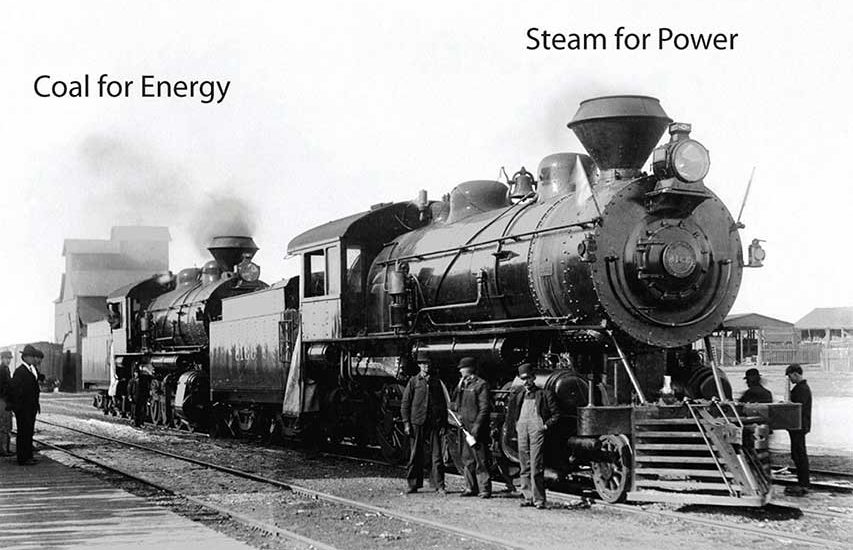
With the mass production of goods and advancements in technology, there was a major shift in human labor. Fewer people were needed on the farms, and more workers were needed in factories. There was a large rural-to-urban shift in the human population. Europe experienced the development of the major cities of its realm during this period. In Britain, for example, in 1800 only nine percent of the population lived in urban areas. By 1900, some 62 percent were urban dwellers. By 2010, it was more than 90 percent. Europe, as a whole, is about 75 percent urban. As a comparison, the US population is about 80 percent urban.
As discussed in earlier sections, the rural-to-urban shift that began with the Industrial Revolution in Europe continues today in developing countries. The Industrial Revolution, which started in northern England’s Pennine mountain chain, rippled through Europe and across the Atlantic to the United States. The majority of countries in Europe are currently in stage 5 of the demographic transition. The five stages of the demographic transition illustrate a pattern of development and population dynamics for a country or region. The model outlines how rural societies with an agrarian economy in stage 1 can make the transition to stage 5: the stage that indicates an urban society with a consumer economy. As a general trend, when a country’s levels of industrial activity and urban growth rise, the outcome is usually a higher standard of living and smaller family sizes. Additionally, rural-to-urban shift takes place, driven by the pull of opportunities and advantages in the industrializing and urbanizing areas. Countries in stage 5 have small families with a fertility rate below the replacement level. Their incomes, based on a consumer economy, are generally at high levels.
As Europe industrialized and progressed through the stages of the demographic transition, certain core regions reached the postindustrial stages earlier than others. Western Europe established a core industrial region with an extended periphery. The postindustrial activity in this core area continues today in four main centers of innovation: (1) Stuttgart in southern Germany, (2) Lyon in southeastern France, (3) Milan in northern Italy, and (4) Barcelona in northeastern Spain. These four industrial centers have been referred to by some as the Four Motors of Europe because they promote business and industry for the European community. The European core region extends as far as Stockholm in the north to Barcelona in the south.
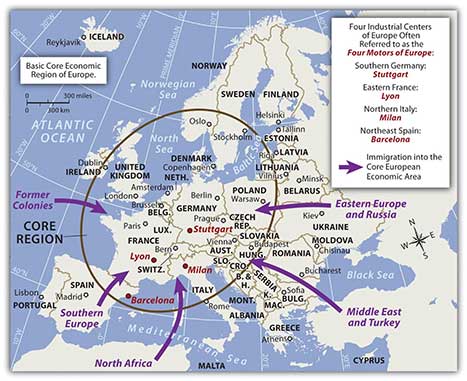
Attractive “pull” forces draw immigrants to the core economic area of Europe, seeking opportunity and advantage. “Push” forces cause people to leave other areas due to negative cultural or environmental forces, and/or the lack of opportunity and advantage.
D. Central Business Districts and Primate Cities
European urban development centered on port cities that had industrial activity. Ships could import raw materials, the factories could manufacture the goods, and the ships could export the products. A central business district (CBD) developed around these activities. Since walking was the main transportation mode, all business activities had to be located in the same vicinity. Banks, retail shops, food markets, and residential dwellings had to be close to the factories and port facilities. Modern cities emerged from this industrialization process, and Europe is one of the more urban realms on the planet.
Many European countries have what geographers call a primate city. A primate city is a city that is much more than twice as large as the country’s second-largest city and is especially important, usually dominant economically, culturally, and/or politically (although not all primate cities are national capitals). Primate cities represent a country’s persona and often are symbolic of the country’s heritage and character. Though common, not all countries of the world have a primate city. Financial and business centers in cities such as London, Rome, or Paris support the industrial activity that led to their development as primate cities. Most primate cities are ports or are located on a major river.
E. Rural-to-Urban Shift and Population Growth
Consider the trend that the Industrial Revolution brought to Europe. As countries industrialize and urbanize, family size naturally goes down and incomes traditionally go up. Integrate this with the rural-to-urban shift that occurs when countries progress through the five stages of the index of economic development. By understanding these basic trends, one can determine the average family size in Europe and why it is declining.
Because Europe is an urbanized realm, family size in Europe is small. As a matter of fact, various countries in Europe have negative population growth rates. Family size (or, more precisely, the fertility rate) in Spain and Italy is around 1.2, with the average family size in all of Europe at 1.4 children. The replacement rate to maintain an even population-growth pattern would be a fertility rate of about 2.1 children. Small families do not provide enough young people to cover the available entry-level service jobs. Most countries in Europe are in stage 4 or 5 of the demographic transition and are facing low or negative population growth and a deficit in their labor supply. As a core economic global power, Europe has experienced an increase in immigration. With a lower fertility rate and an increase in postindustrial activity, Europe is a magnet for people from poorer peripheral countries and even peripheral regions within Europe who are looking for opportunities.
With the planet’s human population increasing overall, one might think that a smaller family size is a positive trend. It may be, but there are challenges as well. If there are fewer young people in a community—fewer children and fewer people of employment age—consider how this affects the economic situation. With a declining European population, who will apply for the entry-level jobs? Who will support the growing numbers of retirees?
Economic core areas attract immigrants seeking opportunities and advantages. Europe follows this pattern. There have been increasing tensions between the long-standing European cultural groups and immigrants from developing countries who often speak non-European languages or follow religions other than Christianity. The main religion of immigrants from North Africa or the Middle East is Islam, which is the fastest-growing religion in Europe.
F. Nation-States and Devolution
The agrarian revolution and the Industrial Revolution were powerful movements that altered human activity in many ways. Innovations in food production and the manufacturing of products transformed Europe, which in turn impacted the rest of the world. Even before the agrarian revolution was under way, other transitions in European political currents were undermining the established empire mentality fueled by warfare and territorial disputes. The political revolution that transformed Europe was a result of diverse actions that focused on ending continual warfare for the control of territory and introducing peaceful agreements that recognized sovereignty of territory ruled by representative government structures. Various treaties and revolutions continued to shift the power from dictators and monarchs to the general populace.
The political revolutions laid the groundwork for a sense of nationalism that transformed Europe into nation-states. The term nation refers to a homogeneous group of people with a common heritage, language, religion, or political ambition. The term state refers to an independent, self-governing political unit; for example, the United States has a State Department with a secretary of state who represents the entire country. In international usage, and in this textbook, the term state can generally be thought of as synonymous with the word country, unless specifically referring to a smaller political unit within a country, such as states in the US or Mexico. When nations and states come together, there is a true nation-state, wherein most citizens share a common heritage and a united government.
European countries have progressed to the point where the concept of forming or remaining a nation-state is a driving force in many political sectors. To state it plainly, most Europeans, and to an extent every human, want to be a member of a nation-state, where everyone is alike and shares the same culture, heritage, and government. The result of the drive for nation-states in Europe is an Italy for Italians, a united Germany for Germans, and a France for the French, for example. The truth is that this ideal goal is difficult to come by. Though the political borders of many European countries resemble nation-states, there is too much diversity within the countries to consider the ideal of creating a perfect nation-state a reality.
Various ethnic populations in Europe desire their own nation-states. They want to devolve or separate from the larger state. The term devolution refers to the process whereby regions or people within a state demand independence and autonomy at the central government’s expense. There are now a number of cases where devolution is occurring in Europe. For example, Scotland and Wales seek to devolve from the United Kingdom. The Basque region between Spain and France would like to have its own nation-state. Former Yugoslavia broke up into seven smaller nation-states. Various other minority groups in Europe seek similar arrangements. Thus both cohesive cultural forces and divisive cultural forces are active in the European community.
G. Centrifugal and Centripetal Forces
Cultural forces continually apply pressure on a country. Some of these cultural forces pull the nation together (centripetal forces) and others pull it apart (centrifugal forces). Primary sources of these cultural forces include religion, language, ethnicity, politics, and economic conditions.
When there is division, conflict, or confrontation, the centrifugal forces are at play. When unification, agreement, or nationalism are being exercised, centripetal forces are evident. The sources that tie a country together can also be the sources that divide a country. Ethnic unity can be a positive force, while ethnic division and conflict can be a divisive force. If centrifugal forces become strong, the result may be outright civil war, as was seen in the United States in the 1860s. Unity can also be evident through national struggles, such as the nationalism displayed immediately after the 9/11 terrorist attacks in the United States. After the attacks, an outpouring of goodwill and agreement strengthened the bonds within the United States.
To understand our world, it is helpful to understand the cultural forces that are active in any one location. Disagreement, inequity, or injustice related to the cultural factors of ethnicity, religion, language, and economics of a region or country is the cause of most conflicts.
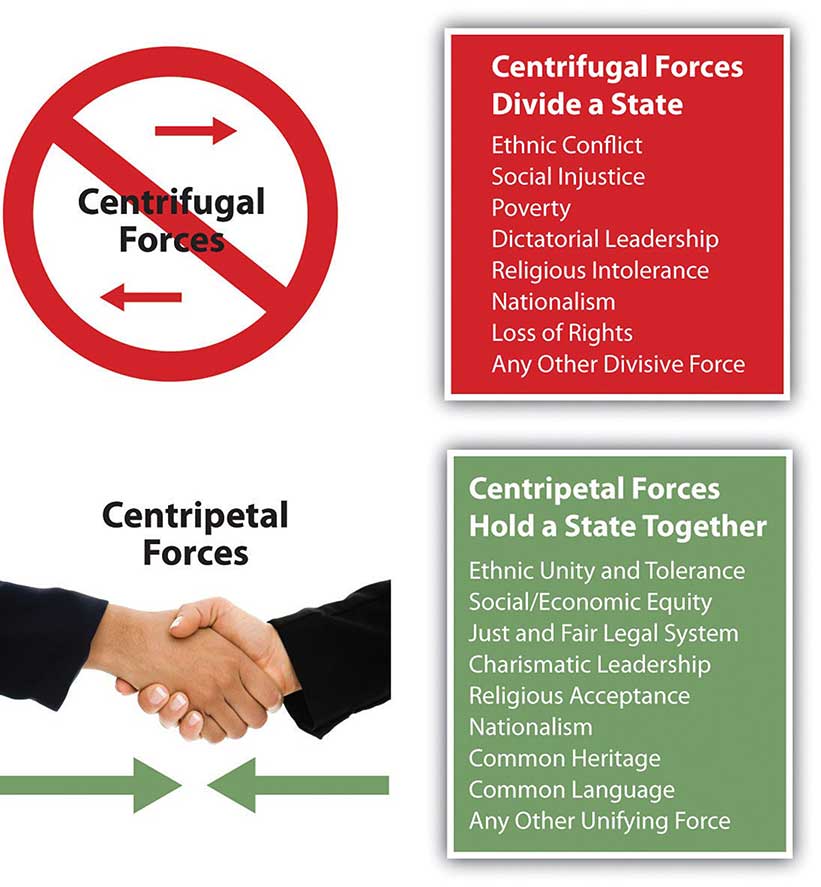
H. Religion and Language in Europe
Europe has historically been considered a Christian realm. The three main branches of Christianity in Europe are Roman Catholic, Protestant, and Eastern Orthodox. Rome has been the geographical base for the Roman Catholic Church since the Roman Empire. Operating on the Romance language of Latin, the Catholic Church has provided southern Europe with a common religion for over 1,500 years.
The Roman Catholic Church split when Constantinople, now called Istanbul, gained preeminence. The Eastern Orthodox Church launched itself as the primary organization in the Slavic lands of Eastern Europe and Russia. The reformation of the fourteenth century, led by people such as Martin Luther, brought about the Protestant Reformation and a break with the Roman Catholic Church. Protestant churches have dominated northern Europe to this day.
Three main Indo-European language groups dominate Europe. Though there are additional language groups, the dominant three coincide with the three main religious divisions. In the east, where the Eastern Orthodox Church is dominant, the Slavic language group prevails. In the north, along with Protestant Christianity, one finds the Germanic language group. In southern Europe, where Roman Catholicism is dominant, the Romance languages are more commonly spoken.
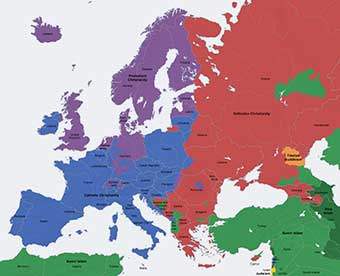
Key Takeaways
- The Roman Empire connected southern Europe and created an infrastructure to help promote trade and intercultural connections. The Vikings connected northern Europe through trade and exploitation.
- Technological advancements helped European colonialism dominate other countries and exploit their labor and resources. Coastal European countries created colonies and external sources of wealth.
- The Industrial Revolution was promoted by the development of steam power with coal as a fuel source. The mass production of goods gave the European countries an advantage in the world marketplace.
- The Industrial Revolution prompted a shift in population from the rural agricultural regions to the urban centers. More people were needed in the factories and fewer workers were required on the farms because of improved agricultural methods. This shift resulted in smaller families and more women entering the workplace.
- The early empires of Europe gave way to the concept of a similar people (the nation) unifying under a common government (the state) to create nation-states.
- Divisive centrifugal cultural forces tend to divide and separate people in a state, whereas cohesive centripetal cultural forces tend to unify a state.
- The Indo-European language family has three dominant groups in Europe: Germanic in the north, Romance in the south, and Slavic in the east. The Christian religion has three main divisions in Europe: a Protestant north, Catholic south, and an Orthodox east.
2.3 The European Union and Supranationalism
Learning Objectives
- Outline how Europe has been divided during the twentieth century.
- Describe the measures or methods that have been implemented to help unify Europe.
- Explain the dynamics of supranationalism and its advantages and disadvantages.
- Summarize how globalization has increased with the advent of the European Union.
The world economy has a competitive marketplace. Each independent country has to compete economically to earn national income, but not all countries are equal in natural or human resources. The smaller countries of Europe may have difficulty competing with the world’s core economic powers such as Japan or the United States. Some of the countries of Europe are small in terms of physical area. In fact, the state of Texas is larger in square miles than any individual European country, and Oregon is larger in size than more than half the European countries. The total physical area of all the European countries together equals only 60 percent of the total physical area of the United States. However, in regard to Europe, physical size may not an indicator of economic ability. A number of European countries possess a high level of economic output and are major forces in the global economy.
The economic forces of globalization have motivated the nation-states of Europe to work together rather than compete with each other. Western Europe as a region is highly industrialized and has a high standard of living. Unified, the countries could be a major economic power in the world. Separately and independently, they may not be able to compete at the same level as other globally recognized trading blocs. To become unified after a century of centrifugal forces dividing them has not been easy. Consider the cultural forces that have been active in Europe. Centripetal forces unifying the realm include a common Christian religion, Indo-European language groups, and a Caucasian ethnic background. These forces, however, have not resulted in a unified Europe. The closest resemblance to a unified Europe was the Roman Empire, which was held together by military force.
During the twentieth century, there were three major divisions in Europe, all products of centrifugal forces. First, World War I, which was supposed to be the war to end all wars, divided Europe and the industrialized world. Second, World War II pitted the Axis powers (led by Germany and Italy with Adolph Hitler leading the German contingency) against the Allied powers (led by Great Britain and France with the United States entering later). Third, after World War II, the confrontation between communism and capitalism developed into the Cold War. The Iron Curtain, built of concrete, barbed wire, and land mines, separated Communist Eastern Europe, which was dominated by the government of the Soviet Union, from the capitalist democracies of Western Europe, which were allied with the United States.
A. Unification Efforts in Europe
Despite many problems, since World War II, steady efforts have been made toward European unification. After World War II ended in Europe, the three small countries of Belgium, the Netherlands, and Luxembourg realized that together they would be much stronger and recover more quickly from the war than if they remained separate. Belgium had banking and business; the Netherlands had industry, farming, and the world-class port of Rotterdam on the Rhine River; and Luxembourg had agricultural and mineral resources. To help recover from World War II, in 1944 the three countries signed an economic pact called the Benelux Agreement (after the first letters of each country’s name), which provided a successful example of cooperation.
Implemented from 1948 to 1952, US Secretary of State George Marshall’s Marshall Plan helped rebuild war-torn Europe with American aid and business connections. US businesses and corporations benefited from the increased international trade with Europe. But to deter the European nations from going to war again, there needed to be an economic trade policy that encouraged a strong business climate. In 1957, the more prominent countries of France, West Germany, the Netherlands, Luxembourg, Italy, and Belgium all signed the Treaty of Rome, which created the Common Market. This agreement provided the structure necessary to unify Europe under a European Union (EU) in 1992. The EU was the structure for a common economic system with an agreed-upon governing body, and it was designed as an economic trading bloc that could compete with the United States and Japan. A mechanism was finally in place for a supportive, unified Europe, but it would be up to the independent countries that joined this union to make it work.
B. Supranationalism
Supranationalism is defined as the voluntary association of three or more independent states willing to yield some measure of sovereignty for mutual benefit. The Benelux Agreement of 1944 was a model for European supranationalism. Nations are often hesitant to give up any sense of independence or autonomy, especially with the strong drive toward nation-state status. It is different for the United States: though the United States is not classified as a nation-state because of its ethnic diversity, English is the only major language and the dollar is the national currency. One can drive for three thousand miles across the United States and still experience a similar cultural landscape, complete with the same English-language road signs, identical franchised restaurants, common chain big-box stores, and similar advertising icons. This is not the case in Europe, where each country might have its own language, currency, traffic laws, and legal system. Supranationalism and unification can be a painful process. With common standards and a common currency comes the reality that a common cultural landscape might develop. Supranationalism could erode the uniqueness of each state as Europe becomes more of a “United States of Europe.” To address the differences in the many currencies used in Europe, the EU introduced a common currency called the euro. This solution encountered resistance but has been accepted by most EU members. Most of the old currencies of EU members were phased out and the single currency of the euro has become the standard. Even some countries not currently in the EU have adopted the euro as their national currency.
Unification has created economic problems between the wealthy industrialized countries and the poorer regions of southern Europe. There is disagreement over how taxes or funds will be allocated. The poorer countries would like economic assistance in developing their industries. The wealthier nations are at times resistant to sharing their wealth. Italy has experienced this problem within its borders: Italy’s wealthy northern regions have hinted at separating from their poorer southern regions. This is an age-old problem that confronts governments of most countries.
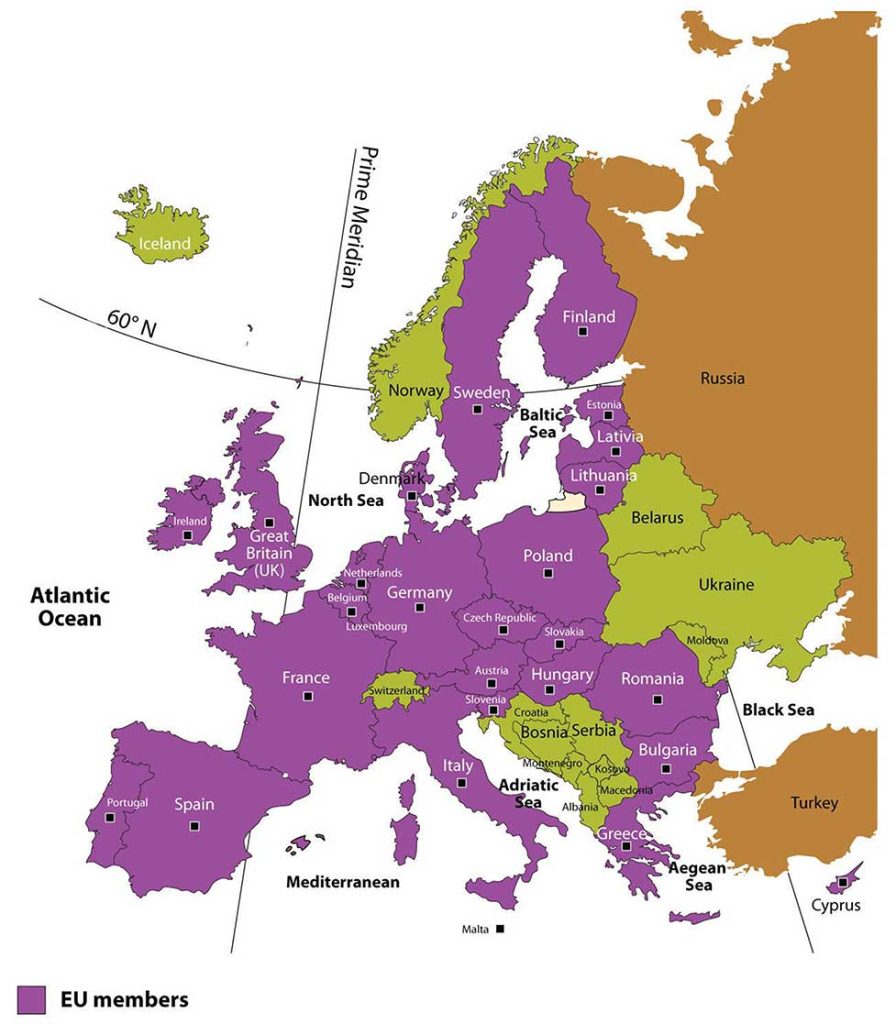
Travel within the EU has also changed. Before the EU, people traveling between European countries encountered border checks at which their passports were checked and stamped, and different traffic laws existed for each country. This is changing. Once inside the EU, there are no more border stops, and traffic and travel are becoming streamlined with common laws, making travel between member nations similar to travel between US states.
European countries have to confront both the centrifugal forces that rally their nations to remain uniquely independent and the centripetal forces that call for integration into the EU, which results in the loss of some of their autonomy. European cultures have a history of struggling to retain their heritage and traditions. The strong devolutionary forces that advocate for nation-state status are challenged by the need to belong to a larger union for economic survival. Europeans are caught between holding on to cultural heritage and moving forward economically in a competitive global economy. Similar forces are also felt in other regions of the world.
Germany, which united its western and eastern regions after the Iron Curtain came down in the early 1990s, has climbed to the top of the economic ladder in Europe. Germany is also the largest country in Europe by population. Other EU nations are concerned that Germany might once again dominate their realm or bring about massive division in Europe. The Cold War, World War I, and World War II are not easily forgotten; they are vital events in European history that affected the whole world. Many Europeans are suspect of what the EU may evolve into. Others welcome a more open European community.
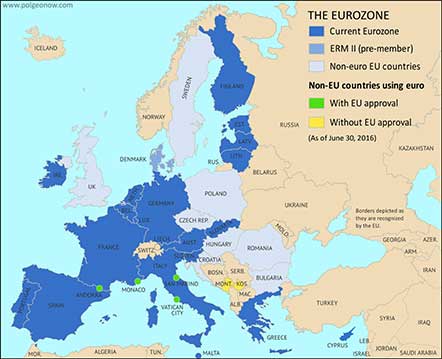
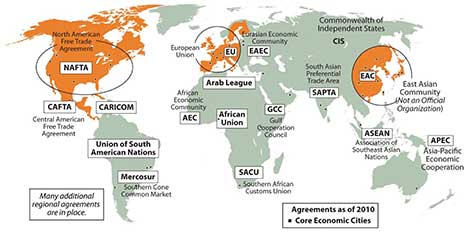
C. About the European Union
According to the 1993 Copenhagen European Council, “a country has to meet certain requirements to join the EU. These requirements include a stable democracy which respects human rights and the rule of law; a functioning market economy capable of competition within the EU; and the acceptance of the obligations of membership, including EU law. Evaluation of a country’s fulfillment of the criteria is the responsibility of the European Council.”
As of 2016, the EU had 28 member states representing just over 500 million people. A number of additional states are applying for membership, so the number of EU member states continues to change. In 2016, there were 24 official EU languages. Each EU state has its own military for national defense. A majority of EU members also hold membership in the North Atlantic Treaty Organization (NATO), which is a political alliance between Western European countries, Canada, and the United States.
The EU is one of many supranational entities. Such economic and political associations have increased across the globe. Competition for labor and resources drives the need for smaller countries to join to compete economically in the global marketplace.
The EU is in the driver seat of one of the three main core economic areas of the world: North America, Western Europe, and Eastern Asia. The EU is an example of what supranationalism can produce. To compete in a global economy, the nation-states of Europe must cooperate and coordinate their industrial activities to support their high standard of living. The EU member states are a part of the elite “have” nations of the world. They face many questions about their future, and they will be watched closely by the rest of the world.
Key Takeaways
- Although World War I, World War II, and the Cold War divided Europe during the twentieth century, the EU emerged as a unifying force for the European people.
- The Benelux Agreement, the Marshall Plan, and the Treaty of Rome all helped set the stage for the European unification that evolved into the EU.
- Supranationalism has provided European countries with the ability to compete economically in the global marketplace. Difficulties have been in the areas of cultural and historical differences that have influenced the continuing economic and political challenges.
- The EU represents a core economic region for the planet. North America and Eastern Asia each have worked to create competitive trading relationships to compete with the EU economically.
2.4 Regions of Europe
Learning Objectives
- Locate and describe the various traditional regions of Europe.
- Outline how the physical geography varies from region to region.
- Explain how each region has met the challenges of retaining its cultural identity or uniqueness.
- Summarize how each region has developed an industrialized economy.
Europe has been traditionally divided into regions based on location according to the four points of the compass: Northern Europe, Southern Europe, Western Europe, and Eastern Europe. The British Isles are often considered a separate region (as they are in this book), but sometimes are included as a part of Western Europe.
The traditional regions of Europe are not as relevant today as they have been historically with the creation of the European Union (EU). Economic and political relationships are more integrated than they were in past eras when nation-states and empires were more significant. Economic conditions have often superseded cultural factors and have intensified the need for increased integration. Cultural forces have traditionally supported nationalistic movements that work to preserve the culture, heritage, and traditions of a people. Regional cultural differences remain the social fabric of local communities that support the retention of their identity. Modern transportation and communication technology has brought this cornucopia of European identities into one single sphere of global recognition.
A. Northern Europe
Europe has many different cultural identities within its continent. Northern Europe has traditionally included Iceland, Finland, and the three Scandinavian countries of Norway, Sweden, and Denmark. These countries are often referred to as the Nordic countries. All these countries were influenced by Viking heritage and expansion. Their capital cities are also major ports, and the largest cities of each country are their primate cities. The languages of the three Scandinavian countries are from the Germanic language group and are mutually intelligible. Finnish is not an Indo-European language but is instead from the Uralic language family. Most of Iceland’s inhabitants are descendants of Scandinavian Vikings. Protestant Christianity has prevailed in northern Europe since about 1000 CE. The Lutheran Church has traditionally been the state church until recent years. These countries were kingdoms, and their royal families remain highly regarded members of society. The colder northern climate has helped shape the cultural activities and the winter sports that are part of the region’s heritage. Peripheral isolation from the rest of Europe because of their northern location and dividing bodies of water have allowed the northern culture to be preserved for centuries and shape the societies that now exist in northern Europe.
Human rights, education, and social concerns are high priorities of the governments of northern Europe, and the quality of these elements rank highly by global comparisons. Standards of living are among the highest in Europe. Isolation in northern Europe does create an element of economic cost, and transportation technology has been leveraged to address this. A modern bridge has been constructed across the Baltic Sea from Denmark to Sweden to increase the flow of people, goods, and materials between the Scandinavian Peninsula and mainland Europe. Iceland is the most remote of the Nordic countries. Its small population—less than a half million people—is connected to Europe by sea and air transportation and communication technologies. Almost all elementary school children in the Nordic countries are taught English as a second language. Fish, meat, and potatoes are traditional dietary staples; fish in particular has been an important food source. The cuisine of the region is not noted for being spicy. Northern Europe has worked diligently to integrate itself with the global community and yet maintain its cultural identity.

As a standard practice, the northern European countries have exploited the opportunities and advantages of their natural resources to expand their economies. Sweden, northern Europe’s largest country, has used its natural iron ore supply to develop its manufacturing sector. Sweden was the production base of Saab and Volvo vehicles as well as other high-tech products; however, GM purchased the Saab auto division in 2000 and some of its automobiles were manufactured in Mexico. In 2010, Saab was sold back to European investors and production resumed in Sweden. Volvo Car Corporation was purchased by Ford Motor Corporation in 1999 and then acquired by a Chinese automaker in 2010.
Finland has vast timber resources and is one of Europe’s major sources of processed lumber. It was the original manufacturer of Nokia cell phones, an example of its technological advancements. Nokia is the largest manufacturer of mobile phones in the world and has production facilities in eight different countries.
Norway has been benefiting from the enormous oil and natural gas reserves under the North Sea. Fishing and modest agricultural activities had been Norway’s traditional means of gaining wealth, but now it is the export of the much-in-demand energy resources. Because of its economic and energy independence, Norway has opted not to join the EU.
Vikings were masters of the seas and colonized Greenland, which is located next to Canada and is considered to be the world’s largest island. Danish colonization in the eighteenth century included Greenland and the Faeroe Islands, which are located between Scotland and Iceland. Both are now under the government of Denmark but retain a high level of self-rule and autonomy, which has aided them in holding on to their cultural identity. Greenland has also opted not to become a part of the EU even though Denmark is a member. Greenland only had a population of about 57,670 in 2011, and 80 percent of its surface is covered with ice. Fish is Greenland’s main export, but minerals, diamonds, and gold are also present in viable amounts.
Denmark has a consumer economy with a high standard of living. This Scandinavian country is often ranked as the least corrupt country in the world and has the happiest people. The country has supported a positive environment and implemented strong measures to protect its natural areas. Denmark’s main exports are food products and energy. The country has sizeable oil resources in the North Sea but also receives over 15 percent of its electricity from wind turbines.
The Baltic states of Lithuania, Latvia, and Estonia have often been included in the northern European designation because of their northern location. Estonia has the strongest similarities in religion, traditions, and culture, and geographic literature often has included it as a part of northern Europe. The Baltic states have been associated with Eastern Europe through the Soviet era but, like their neighbors to the north, are becoming more economically integrated with Western Europe.
Northern Europe is a peripheral region. Southern Sweden has an advanced industrial base and resembles a core area. Sweden’s northern portion and the main parts of the other Nordic countries act as sources of raw materials for Europe’s urban core industrial region. In the core-peripheral spatial relationship, northern Europe most resembles a semiperipheral region that has attributes of both the urban core and the rural periphery.
Norway, Sweden, and Finland are quite large in area but are not densely populated compared with other European nations. Sweden ranks as the fourth-largest European country in physical area. Sweden is larger than the US state of California, but in the 2010 census, it had less than ten million people. In 2010, Finland, Norway, and Denmark all had less than six million people each.
The cultures and societies of northern Europe have progressed along similar paths; that is, they have advanced from once Viking-dominated lands into modern democratic and socially mature nations. Northern Europe is known for its concern for the social welfare of its citizens. Their strong egalitarian ideals have contributed to extensive advancements in free medical care, free education, and free social services for all, regardless of nationality or minority status. Civil rights for minorities, women, and other groups is assured and protected. Denmark doesn’t have a legal age for consumption of alcoholic beverages, though tradition sets the age at about fourteen. Culture and the arts are well developed; examples include everything from the Nobel Peace Prize to Hans Christian Anderson to the 1970s chart-topping pop group ABBA. Sweden has become a major exporter of music worldwide. Rock, hip-hop, and pop music are common genres. With English as a widely spoken language in Scandinavia, music and cultural trends have a larger export market in places such as the United States and Britain.
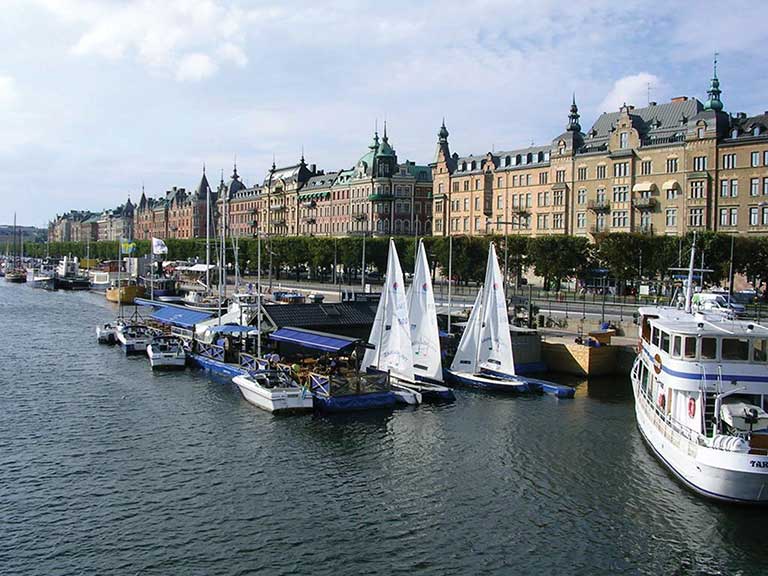
B. Southern Europe
Southern Europe includes three large peninsulas that extend into the Mediterranean Sea and the Atlantic Ocean. The Iberian Peninsula consists of Spain and Portugal. The Pyrenees mountain range separates the Iberian Peninsula from France. Greece, the most southern country on the Balkan Peninsula, includes hundreds of surrounding islands and the large island of Crete. The Italian Peninsula is the shape of a boot with the Apennine Mountains running down its center. Italy also includes the islands of Sicily and Sardinia. Technically, the island country of Cyprus is also included in southern Europe. There are five microstates in this region. The small island of Malta is located to the south of Sicily and is an independent country. Monaco, San Marino, Andorra, and Vatican City are also independent states located within the region. Southern Europe’s type C climate, moderated by the water that surrounds it, is often referred to as a Mediterranean climate, which has mild, wet winters and hot, dry summers.
Rural-to-urban shift in southern Europe has not been as strong as that of Western Europe. Only about 50 percent of the people in Portugal are urban; in Spain and Greece, about 60 percent are urban.
Italy is more representative of Europe, with about 68 percent of the population urbanized. Italy is also divided, with northern Italy being more industrialized than southern Italy. The southern regions of Italy, including the island of Sicily, are more rural with fewer industries. Northern Italy has the metropolitan city of Milan as an anchor for its global industrial and financial sector in the Lombardy region, which includes the city of Turin and the port of Genoa. This northern region of Italy has the economic muscle to be one of Europe’s leading manufacturing centers. The so-called Ancona Line can be drawn across the middle of Italy from Ancona on the east coast to Rome on the west coast to separate the industrial north with the more agrarian south. The north also has the noted cultural cities of Venice, Florence, and Pisa.
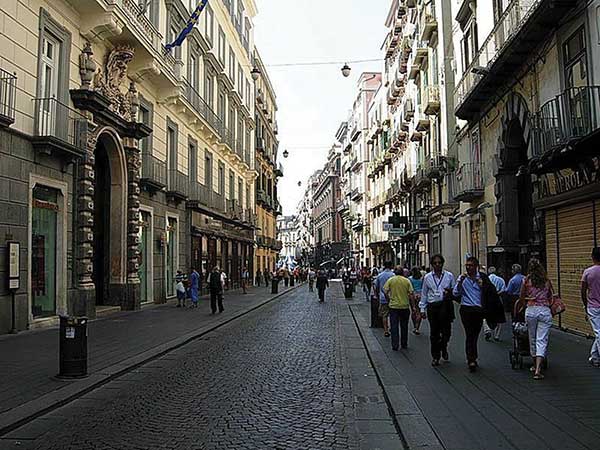
A similar situation exists in Spain. The urbanized Catalonia region around Barcelona in the northeast has high-tech industries and a high standard of living. Southern Spain has large rural areas with economies heavily based on agricultural production. Portugal and Greece are not as industrialized and do not have the same economic opportunities. Historically, southern Europe, Portugal, and Greece in particular each have had a much lower gross domestic product (GDP) per capita than northern or Central Europe. Their economies have been much more aligned with the economic periphery than with the industrial core region of Europe. Greece has had serious economic difficulty in the past few years.
Southern European countries have much larger populations than their northern European counterparts. Italy has about sixty million people in an area smaller than Norway, which has less than five million. Spain has about forty million; both Portugal and Greece have more than ten million. Cultural factors are also different here than in northern Europe. The culture of southern Europe has been built around agriculture. Traditional cuisine is based on locally grown fresh food and wine. Olive oil and wine have been major agricultural exports. The main languages of Iberia and Italy are based on the Romance language group, and Greek is an independent branch of the Indo-European language family. The most dominant religious affiliation in the south is Roman Catholicism, except in Greece, where the Eastern (Greek) Orthodox Church is prominent.
Spain is the most diverse nation in southern Europe with a number of distinct ethnic groups. The Basques in the north along the French border would like to separate and create their own nation-state. The region of Galicia in northwest Spain is an autonomous region and was once a kingdom unto itself. There are many other autonomous communities in Spain, each with its own distinct heritage and culture. Farther east in the Mediterranean is the island state of Cyprus, which is divided by Greek and Turkish ethnic groups. The southern part of the island is dominated by Greek heritage and culture, and the northern part of the island is dominated by Turkish culture and traditions. Islam is the main religion of the Turkish north. The people of southern Europe are diverse and hold to many different traditions but are tied together by the sea and the land, which create similar lifestyles and economic activities.
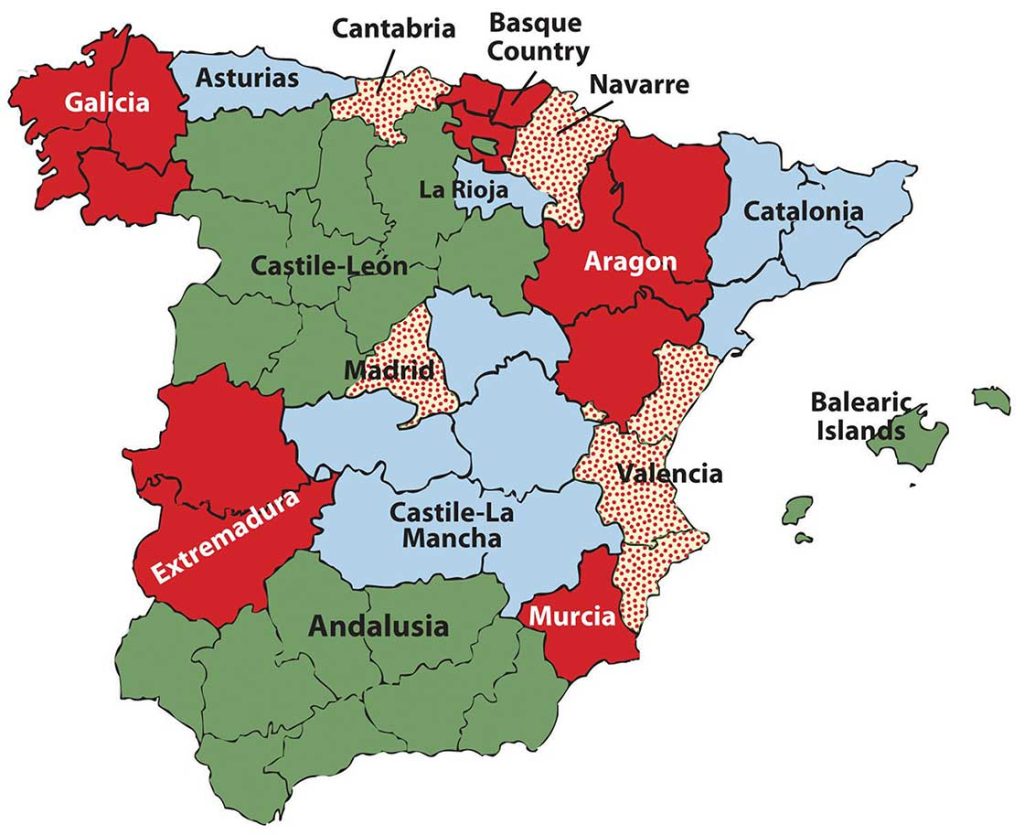
C. Western (or Central) Europe
When discussing the political geography of the European continent, the states located in the western part of the European mainland are often referred to as Central Europe. Germany and France are the two dominant states, with Belgium, the Netherlands, and Luxembourg making up the Benelux countries. Switzerland and Austria border the Alpine region. The microstate of Liechtenstein is located on the border between Switzerland and Austria. France is the only country with coastlines on both the Atlantic Ocean and the Mediterranean. These countries are located in the core economic region of Europe and have stable democratic governments and a relatively high standard of living by world comparisons.
Central Europe is a powerhouse of global economics. The Rhine River is a pathway for industrial activity from southern Germany to Europe’s busiest port of Rotterdam in the Netherlands. Western France has the political capital of the EU along the Rhine at Strasbourg. To the south is France’s second-largest city, Lyon, which is a major industrial center for modern technology. Germany had the historical Ruhr industrial complex along the Rhine that supported the high-tech industries in southern Germany in the cities of Stuttgart, Mannheim, and Munich. Germany is the most populous country in Europe, with over eighty-two million people in 2010. Germany is also Europe’s largest economy and has the largest GDP overall as a country. Belgium has major business centers in Brussels and Antwerp. Switzerland is noted for its banking and financial markets. Luxembourg has one of the highest GDP per capita in all of Europe. Austria is noted for its high level of cultural activities in Vienna and Salzburg. All these countries complement each other in creating one of the dominant economic core areas in the world.
In the first half of the twentieth century, the political geography of Central Europe was not conducive to the high level of economic cooperation that now exists. In World War I and World War II, Germany and France were on opposite sides, and the Benelux countries were caught in the middle. The cultural differences between the Germans and the French start with the differences in language and religious affiliation. Germany was divided after World War II into East Germany and West Germany, separated by the so-called Iron Curtain. East Germany was under a Communist government, and West Germany was a capitalist democracy. They were reunited in 1990 when the Iron Curtain and the Berlin Wall came down. The two countries merged under one government. Europe is gradually being united economically, but each country or region still retains its cultural uniqueness.
The Benelux Countries
The Benelux countries have a great deal in common historically. Before the economic union that created the term Benelux, these countries were collectively referred to as the Low Countries, so called because of their relative position to sea level. The Benelux countries are some of the most densely populated countries. They have managed to work together toward a common economic objective in spite of their cultural differences.
The capital and largest city in Belgium is Brussels, with the other urban areas being the ports of Antwerp and Ghent. Belgium is split into three large geographic areas. The dominant language in the northern region of Flanders is Dutch (Flemish), and the people are known as Flemings. In the southern region of Wallonia, most people speak French and are known as Walloons. German is the third official language and is spoken along the eastern border.
Belgium is a major exporter of manufactured products, including finished diamonds, food products, nonferrous metals, technology, petroleum products, and plastics. In general, Belgium imports the raw materials to manufacture these goods for export. Belgium also has a significant service sector, including real estate, hotels, restaurants, and entertainment, which thrives in part because Brussels is the headquarters of the North Atlantic Treaty Organization (NATO) and components of the EU. Many countries and organizations maintain offices in Brussels to have easy access to these headquarters; therefore, Brussels is the temporary home to many diplomats and foreign business people.
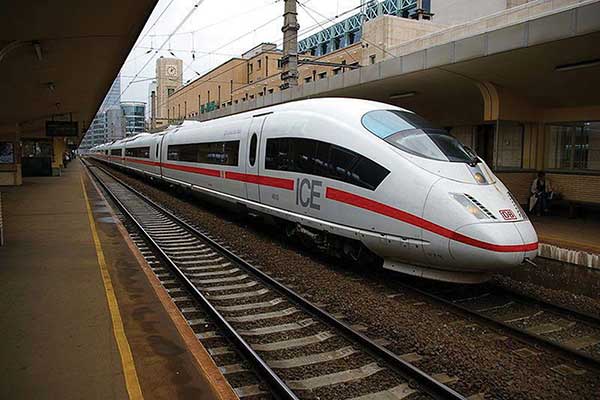
The Netherlands is sometimes called Holland, which is actually the name of two provinces (North Holland and South Holland) in the northwest part of the country. The largest city is Amsterdam. The Hague is the seat of government and is home to the United Nations International Court of Justice. Rotterdam is located at the mouth of the Rhine River and is one of the busiest ports in the world. The country is famous for its Zuider Zee, which is the large inland region below sea level that has been drained of water and surrounded with an extensive dike system to protect it from the North Sea. Reclaimed land from the sea in areas called polders has provided this densely populated country with more land area for its people to expand their activities.
For a small country with few natural resources, the Netherlands has an impressive GDP. The Dutch have made good use of their location on the North Sea and of the location of several large navigable rivers. This has facilitated voluminous exports to the inland parts of Europe. The major industries include food processing, chemicals, petroleum refining, and electrical machinery. The Netherlands is a top exporter of agricultural products, which contribute substantially to its economy. Dutch agricultural exports consist of fresh-cut plants, flowers, and bulbs as well as tomatoes, peppers, and cucumbers.
Luxembourg’s one major city is Luxembourg City. Luxemburg has an enviable economic situation with a stable and prosperous economy, low unemployment, and low inflation. Thanks to rich iron-ore deposits, this country was able to develop a very robust steel industry, which was the cornerstone of the nation’s prosperity until the 1970s. As steel declined, Luxemburg remade itself as an important world financial center. Luxembourg leads Europe as the center for private banking and insurance industries and is second only to the United States in terms of being an investment fund center.
France
France covers 211,209 square miles and is the second-largest European country in area; only Ukraine is slightly larger. The physical landscapes of France vary widely from the northern low-lying coastal plains to the Alpine ranges of the east. Mont Blanc, the highest mountain in the Alpine range at 15,782 feet, is located in France near the Italian border. In the far south, the Pyrenees run along the border with Spain. The south-central region of the country is home to the Massif Central, which is a plateau and highland region made up of a large stretch of extinct volcanoes.
During the colonial era, France was a major naval power and held colonies around the world. The French Empire was the second largest at the time. The French language is still used for diplomacy in many countries. Though the French Empire no longer exists, France has progressed into a postindustrial country with one of the most developed economies in the world. It is a major player in European affairs, the EU, and the United Nations (UN). France is a democratic republic that boasts a high-quality public education system and long life expectancies.
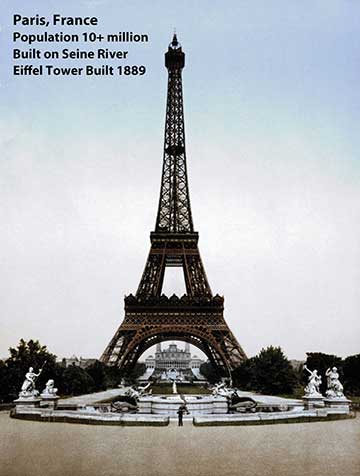
In 2010, France’s population was about sixty-five million, with about ten million living in France’s primate city of Paris. The city of Paris is on an excellent site, favorably situated with regard to its surrounding area. It is the core area of France serving a large peripheral region of the country. The next largest city of Lyon, which is a major high-tech industrial center for Europe’s economy, only boasts a population of about 1.4 million. Even with a large population, the country is able to produce enough food for its domestic needs and for export profits.
France enjoys a robust economy and is one of the world’s leading industrial producers. Its industrial pursuits are diverse, including the manufacture of planes, trains, and automobiles, as well as textiles, telecommunications, food products, pharmaceuticals, construction and civil engineering, chemicals, and mechanical equipment and machine tools. Additionally, defense-related industries make up a significant sector of the economy. France’s production of military weapons is recognized worldwide. The country has been a leader in the use of nuclear energy to produce electricity. Nuclear energy supplies about 80 percent of the country’s electricity, which reduces the need for fossil fuels and imported oil.
Agriculture is an important sector of the French economy, as it has been for centuries, and is tied to industry through food processing. Food processing industries employ more people than any other part of the French manufacturing sector. If you think of cheese and wine when you think of France, you have identified two of its largest food processing endeavors, along with sugar beets, meats, and confectionaries. World-renowned wines are produced in abundance, sometimes in areas that bear their names, such as in Burgundy, around the city of Bordeaux, and in Champagne in the Loire Valley. French cuisine and fashion have long been held in highest esteem worldwide and are a source of national pride.
Thanks to the climate and favorable soil conditions, agriculture is highly productive and lucrative for France. France is second only to the United States in terms of agricultural exports. Exports mainly go to other EU countries, to the United States, and to some countries in Africa. France leads Europe in agricultural production.
The plains of northern France are excellent for wheat. Dairy products are a specialty in the western regions of France, which also produce pork, poultry, and apples. Beef cattle are raised in the central portion, where a cooler, wetter climate provides ample tracts of grasslands for grazing. Fruit, including wine grapes, is grown in the central and southern regions, as are vegetables. The region around the Mediterranean is blessed with hot, dry weather ideal for growing grapes and other fruits and vegetables.
Germany
Germany’s location in Central Europe has meant that throughout history many peoples—all with their own cultures, ideas, languages and traditions—have traversed Germany at one time or another. Thus Germany’s culture has received many influences over the centuries.
Germany’s present geopolitical configuration is quite young, as it reunified the eastern and western portions into a single entity in 1990. Germany was formed in 1871 during the leadership of Otto von Bismarck in an attempt to create a Germanic power base. World War I was fought during the last years of the German Empire. Germany, as part of the Central powers (Germany, Austria-Hungary, and Bulgaria), was defeated by the Allies with much loss of life. The German Republic was created in 1918 when, having been defeated in World War I, Germany was forced to sign the Treaty of Versailles.
In 1933, with an environment of poverty, disenfranchisement of the people, and great instability in the government, Germany gave way to the appointment of Adolf Hitler as chancellor of Germany. Within a month of taking office, Hitler suspended normal rights and freedoms and assumed absolute power. A centralized totalitarian state quickly resulted. In a move to expand Germany, Hitler started to expand its borders. Germany’s invasion of Poland in 1939 kicked off what would become World War II. In 1941, Germany invaded the Soviet Union and declared war on the United States. After Germany’s defeat, the country was divided into East Germany, controlled by the Soviet Union, and West Germany, controlled by the Allied powers. The Iron Curtain divided the two Germanys, with the Berlin Wall dividing the city of Berlin. The Iron Curtain and the Berlin Wall were major symbols of the Cold War. In 1989, the Berlin Wall came down, and the two Germanys were reunited in 1990. Today, Germany is a vibrant country and an active EU member.
Germany is Europe’s largest economy, with strong exports of manufactured goods. Most exports are in automobiles, machinery, metals, and chemical goods. Germany has positioned itself strategically to take economic advantage of the growing global awareness of environmental issues and problems by focusing on improvements and manufacturing of wind turbines and solar power technology. The service sector also contributes heavily to the economy. Deutsche Bank holds the enviable position of being one of the most profitable companies on the Fortune 500 list. Germany is also a major tourist destination. The Black Forest, Bavaria, the Alpine south, a variety of medieval castles, national parks, and a vibrant assortment of festivals such as Oktoberfest attract millions of tourists to Germany every year.
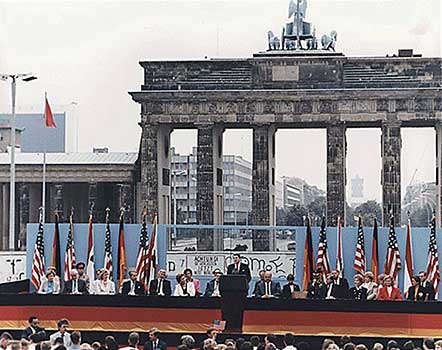
The Alpine Center
Landlocked in the center of Europe are the two main states of Switzerland and Austria. Sandwiched on the border of these two states is the microstate of Liechtenstein. This region is dominated by the Alpine ranges. Switzerland, officially known as the Swiss Confederation, is divided into twenty-six cantons (states). Because of its location and close ties with neighboring countries, four official languages are spoken in Switzerland: German, French, Italian, and Romansh. Typically, one language predominates in any given canton. Berne is the country’s capital, and Geneva, Zurich, and Basel are the other major cities. As of 2010, Switzerland’s population was about 7.8 million.
Internationally, Switzerland is known for its political neutrality. The UN European offices are located there. The Red Cross and the main offices of many international organizations are located in Switzerland. Switzerland joined the UN in 2002 and has applied for EU membership. Swiss culture is thought to have benefited from Switzerland’s neutrality. During times of war and political turmoil, creative people found refuge within the Swiss borders. Swiss banking practices and policies are known throughout the world, and Swiss banks have benefited greatly from the country’s politically neutral status. Banking is one of the country’s top employers and sources of income. The Swiss people enjoy a high standard of living.
Austria is larger than Switzerland and is similar in area to the US state of South Carolina. In 2010, the population was estimated at 8.4 million. Austria has various Alpine ranges, with the highest peak at 12,457 feet in elevation. Only about a fourth of the land area is considered low lying for habitation. The Danube River flows through the country, including the capital city of Vienna. Austria has a well-developed social market economy and a high standard of living.
Austria is a German-speaking country, and nearly the entire population self-identifies as ethnic Austrian. It is also predominantly Roman Catholic and was home to many monasteries in the Middle Ages, influencing a strong Austrian literary tradition. Austria’s best-known cities are its capital of Vienna and Salzburg and Innsbruck. Vienna was the center of the Habsburg and Austrian Empires and earned a place as one of the world’s great cities. It is famed for its baroque architecture; its music, particularly waltzes; and theater.
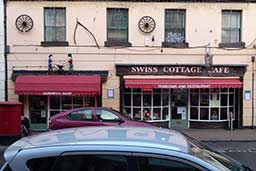
D. The British Isles
The British Isles are an archipelago (group of islands) separated from the European mainland by the English Channel. The British Isles are often included in the region of Western Europe when discussing political geography; however, the fact that they are separated from the mainland of Europe by water provides them with a separate identity. The British Isles consist of two separate, independent countries: the Republic of Ireland and the United Kingdom. The United Kingdom (UK) of Great Britain and Northern Ireland consists of the regions of England, Scotland, Wales, and Northern Ireland. All four regions are now under the UK government. The Republic of Ireland, consisting of the southern portion of the island of Ireland, is independent of the United Kingdom and does not include Northern Ireland. The primate city and UK capital is London, which is a financial center for Europe. The capital city of the Republic of Ireland is Dublin.
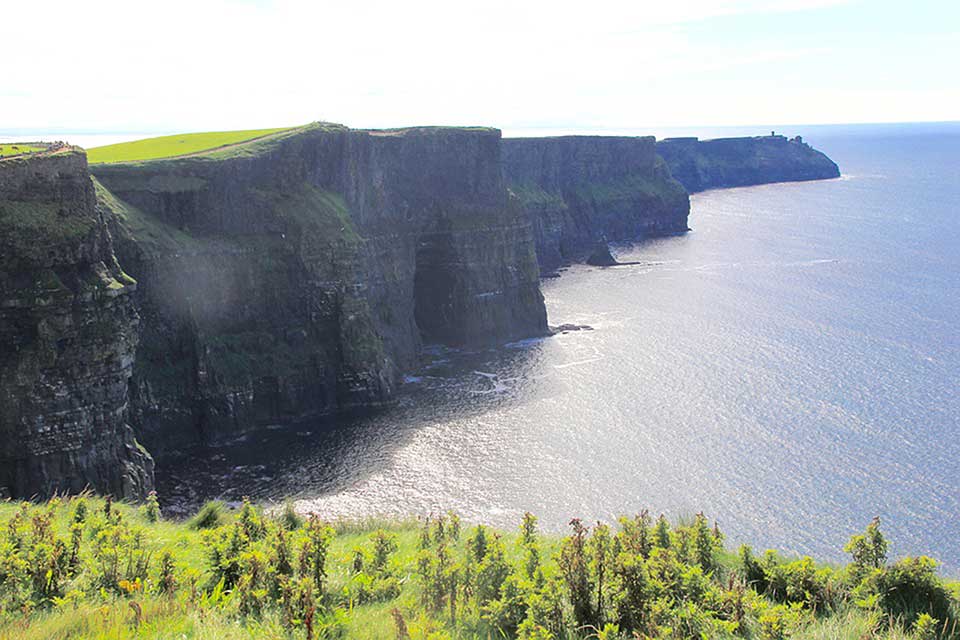
Influenced by the Gulf Stream, the climate of the British Isles is moderate, in spite of its northern latitude location. The UK and Ireland are located above the fiftieth degree of latitude, which is farther north than the US-Canadian border. The northern latitude would normally place this region into the type D climates, with harsher winters and more extreme seasonal temperatures. However, the surrounding water moderates temperature, creating the moderate type C climate that covers most of the British Isles. The Gulf Stream pulls warm water from the tropics and circulates it north, off the coast of Europe, to moderate the temperature of Western Europe.
The Western Highlands and the Northern Lowlands dominate the islands. Scotland, Wales, and parts of England have highland regions with short mountains and rugged terrain. The lowlands of southern England, Ireland, and central Scotland offer agricultural opportunities. The Pennines mountain chain runs through northern England and was the source of the coal, ores, and waterpower that fueled the Industrial Revolution. To the east of Britain is the North Sea, which provided an abundance of petroleum resources (oil) for energy and wealth.
Though the heritage of the British Isles is unique to this region, the geographic dynamics are similar to Central Europe—that is, smaller families, urbanization, industrialization, high incomes, and involvement with economic globalization. The EU has had an enormous influence on the British Isles. Ireland has embraced EU’s economic connections, but the British people have been hesitant to relinquish full autonomy to the EU. This reluctance can be noted in the fact that the United Kingdom kept the British pound sterling as their currency standard after the euro currency was implemented. However, the Republic of Ireland converted to the euro currency.
The regions of the British Isles follow similar dynamics to those of other countries in Western Europe. Though some regions are not as wealthy as others, they all demonstrate a high level of industrialization, urbanization, and technology. These urban societies have smaller families and higher incomes and are heavy consumers of energy, goods, and services. Just as the Industrial Revolution attracted cheap labor, the aging workforce has enticed people from former British colonies to migrate to the United Kingdom in search of increased employment opportunities. The mix of immigrants with the local heritage creates a diverse community. London has diverse communities with many ethnic businesses and business owners.
Devolutionary forces are active in the United Kingdom. Scotland and Wales are already governing with their own local parliaments. Devolutionary cultural differences can be noted by studying the different heritages found in each region. Just as the Welsh language is lingering in Wales, Gaelic continues in Ireland and Scotland. Each region has made efforts to retain local heritage and rally support for its own nation-state. Until recently, this was all done under the umbrella of the EU. However, in June 2016, voters in the UK as a whole voted for a British exit, or “Brexit,” from the EU. In Scotland, though, the majority voted to remain in the EU, prompting calls for another Scottish referendum on Scottish independence. It may take years for these issues to be resolved.
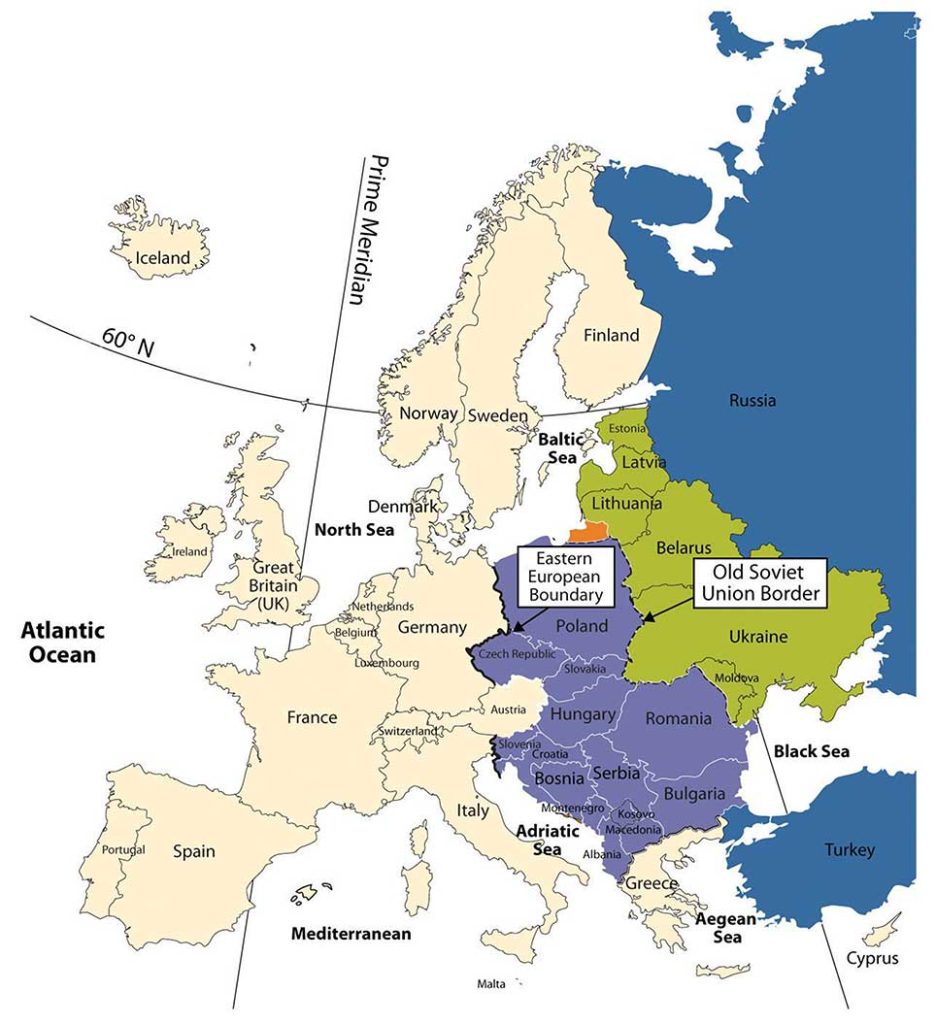
E. Eastern Europe
After World War II ended in 1945, Europe was divided into Western Europe and Eastern Europe by the Iron Curtain. Eastern Europe fell under the influence of the Soviet Union, and the region was separated from the West. When the Soviet Union collapsed in 1991, all the Soviet Republics bordering Eastern Europe declared independence from Russia and united with the rest of Europe. The transition Eastern Europe has experienced in the last few decades has not been easy; however, most of the countries are now looking to Western Europe for trade and economic development. Cooperation continues between Eastern and Western Europe, and the European Union (EU) has emerged as the primary economic and political entity of Europe.
The collapse of Communism and the Soviet Union led to upheaval and transition in the region of Eastern Europe in the 1990s. Each country in the region was under Communist rule. The countries bordering Russia were once part of the Soviet Union, and those countries not part of the Soviet Union were heavily influenced by its dominant position in the region. When the Soviet Union collapsed in 1991, the bordering countries declared independence and began the process of integration into the European community. Moldavia changed its name to Moldova. The countries of Czechoslovakia and Yugoslavia each broke into multiple countries and, because of the diverse ethnic populations, organized around the concept of nation-states. Czechoslovakia peacefully agreed to separate into two states: the Czech Republic and the Republic of Slovakia. Yugoslavia was not so fortunate. After a series of wars that raged throughout the 1990s (collectively called the Yugoslav Wars), the country eventually devolved into seven independent countries: Slovenia, Croatia, Bosnia and Herzegovina, Serbia, Montenegro, Kosovo, and Macedonia.
Most Eastern European political borders coincide with ethnic boundaries. Each of the regions once resembled nation-states. In principle, Romania is set apart for Romanians, Hungary for Hungarians, and so on. Few are true nation-states because of ethnic minorities located within their borders, but the countries held on to their common heritage throughout the Communist era. In most Eastern European countries, cultural forces have brought people together to publicly support the move to unite and hold onto a heritage that is as old as Europe itself.
Governments that were controlled by Communist dictators or authoritarian leaders before 1991 were opened up to democratic processes with public elections. With the fall of Communism came economic reforms that shifted countries from central planning to open markets. Under central planning, the governments dictated which products were produced and how many of each were to be produced. The open markets invited private capitalism and western corporate businesses.
The power of the state was transferred from the Communist elite to the private citizen. People could vote for their public officials and could choose businesses and work individually. With the EU looming over the realm, the now-independent countries of Eastern Europe shifted their economic direction away from Moscow and the collapsing Communist state and toward the core industrial countries of Western Europe and the EU.

Key Takeaways
- Europe can be divided into a number of smaller geographic regions, including Northern Europe, Southern Europe, Western Europe, the British Isles, and Eastern Europe.
- Differences in climate, terrain, and resources provide for diverse economic activities that influence cultural development within Europe.
- The countries of Northern and Western Europe and the British Isles have high standards of living by world standards. The southern countries of Portugal, Greece, and southern Italy are more agrarian and have been struggling economically since the global recession began in 2007.
- The British Isles comprise the two independent countries of the United Kingdom and the Republic of Ireland. The UK consists of four administrative units (England, Scotland, Wales, and Northern Ireland), with Wales and Scotland having more autonomy to govern local affairs.
- Since World War II, the many states of Europe have been evolving into a more integrated realm. Each nation has worked to develop its economy to take advantage of its physical geography and its cultural history and heritage. Devolutionary forces remain strong in many areas to counterbalance the forces of supranationalism.
- After World War II ended, Europe was divided into Western Europe and Eastern Europe by the Iron Curtain. Western Europe promoted capitalist democracies, and Eastern Europe came under the Communist influence of the Soviet Union. After the collapse of the Soviet Union in 1991, Eastern Europe began to transition toward Western European ideals, including shifting toward democratic governments, open market economies, private ownership, and the EU.
- Countries with stable governments and industrial potential have been accepted into the EU and have expanding economies. Other countries that have not reached that level of economic development or political reforms have not been admitted into the EU.
End-of-Chapter Summary
The European continent extends from the North Atlantic Ocean to the Ural Mountains in Russia. The Russian segment of the European continent is usually studied with Russia as a whole. Europe is bordered by the Arctic Ocean to the north, the Atlantic Ocean to the west, and the Mediterranean Sea to the south.
The Gulf Stream helps create a type C climate for much of Western Europe. Type D climates dominate the north and eastern portions of Eastern Europe. Europe has four main physical landforms that provide a diversity of resources for human activity.
European colonialism brought increased wealth and economic activity to Western Europe. The Industrial Revolution also began here. Europe developed into an industrialized realm with powerful economic forces that continue to drive the postindustrial engine of globalization. Rural-to-urban shift and urbanization were products of industrialization. The result for Europe has been smaller families and higher incomes.
The Roman Empire created early networks of infrastructure for southern Europe, while the Vikings connected northern Europe through trade and warfare. The latest attempt to unify the European nations is through supranationalism in the formation of the European Union (EU). Countries that have strong economies and stable governments are allowed to join the EU.
Europe can be divided into various geographic regions based on the points of the compass. The distinctions often relate to the type of economic activity the people are engaged in or are based on cultural traits such as the variations of Christianity or the branches of the Indo-European language.
Since the Soviet Union’s collapse in 1991, Eastern Europe has been transitioning from Communist governments to democratic governments with capitalist-style economies. Some countries have made this transition more easily than others. Many of the more progressive countries have been accepted into the EU. Other countries continue to struggle to establish stable democratic governments and a growing economy.
